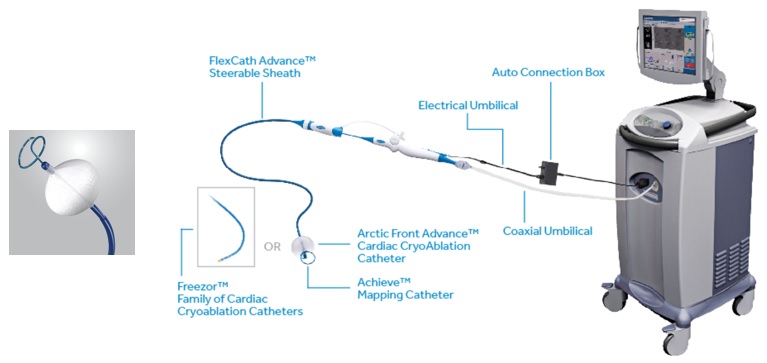The Arctic Front Advance™ and Arctic Front Advance Pro™ and The Freezor Max™ Cardiac Cryoablation Catheters - P100010/S098
This is a brief overview of information related to FDA's approval to market this product for expanded use. See the links below to the Summary of Safety and Effectiveness Data (SSED) and product labeling for more complete information on this product, its indications for use, and the basis for FDA's approval of a new use.
Product Name:
- Arctic Front Advance™ Cardiac Cryoablation Catheters
- Arctic Front Advance Pro™ Cardiac Cryoablation Catheters
- Freezor™ MAX Cardiac Cryoablation Catheter
- CryoConsole
- Manual Retraction Kit
PMA Applicant: Medtronic Inc.
Address: 8200 Coral Sea Street N.E., MVS46, Mounds View, MN 55112
Approval Date: June 23, 2020
Approval Letter: Approval Order
What is it? The Arctic Front Advance and Artic Front Advance Pro Cardiac Cryablation Catheters are balloon-tipped catheters that use cold energy to treat a condiction called atrial fibrillation (AF), which is an abnormal heart rhythm causing fast and irregular heartbeats. The Freezor Max Cardiac Cryoablation Catheter is a secondary catheter that also uses cold energy to treat areas of the heart that the balloon-tipped catheters can not reach. The CryoConsole is the source of the gas used to make both catheters cold.
The FDA peviosuly approved these catheters to treat patients with AF episodes that begin suddently and then stop on their own or with treatment within seven days (paroxysmal AF). This approval expands the indications for use to treat patients with AF episdoes that last for more than seven days but less than six months (persistent atrial fibrillation of less than six months duration). Compared with paroxysmal AF, persistent AF is often harder to treat.
How does it work? A doctor puts the balloon-tipped catheter through a small cut in a vein in the groin and moves the tip of the catheter up to the heart. The balloon is then inflated at the opening of a vein that drains blood from a lung to the heart (called a pulmonary vein). The doctor then sends gas into the balloon to make it very cold. The cold balloon is used to freeze (ablate) the heart tissue in order to block abnormal electricalsignals conducting from the pulmonary vein to the heart that cause the abnormal heart rhythm. This is repeated until all pulmonary veins are treated. The Freezor Max catheter is used to ablate the heart tissue when certain areas of the heart cannot be reached by the balloon-tipped catheter. The doctor removes both catheters after treatment.
When is it used? A doctor uses these catheters to treat patients who have paroxysmal AF or persistent AF of less than six months duration that causes symptoms and does not respond to medicine.
What will it accomplish? In a clinical study doctors used these catheters to treat 150 patients with persistent AF of less than six months duration and AF-related symptoms who did not respond to a medicine to correct the abnormal heart rhythm. The patients were followed for one year and the abnormal heart rhythm did not return in 52.1% of patients.
When should it not be used?
The catheters should not be used in patients who:
- Have infections in their bloodstreams.
- Have tumors or clots inside their hearts.
- Have a small mesh tube (called a stent) placed in the pulmonary vein.
- Have a blood thickening disorder called cryoglobulinemia.
Additional information (including warnings, precautions, and adverse events):

